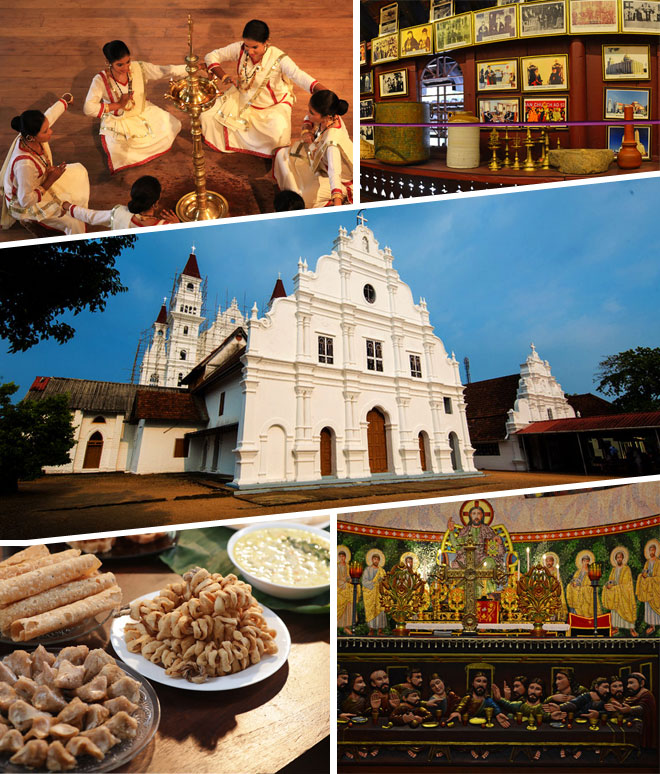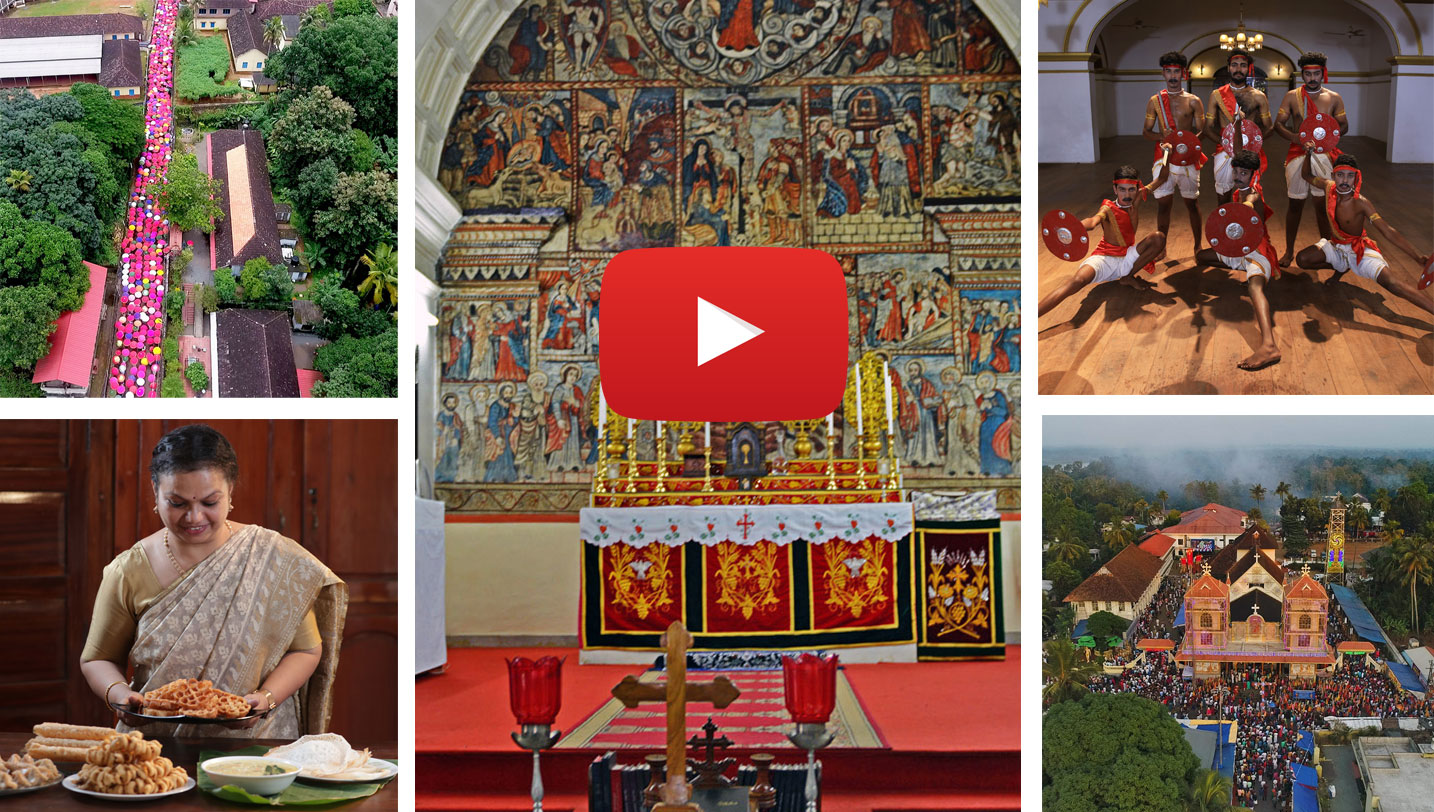Portuguese Forts
When the Portuguese reached Kochi, the ruler of Kochi is said to have accommodated them in his palace and provided land for procuring pepper. Many warehouses came up in Kochi and Mattancherry at that time. Their remnants are still there. There are documents to show that the merchandise was given on credit. It was the threat posed by the Zamorin that prompted the ruler of Kochi to help the Portuguese (Melekandathil, Pius, Portuguese Cochin and Maritime Trade in India).
The Portuguese established trade links with the ruler of Kannur in 1501 and of Kollam in 1503. They constructed the St Angelo’s Fort in Kannur in 1505, and the St. Thomas fort in Thankassery in CE 1518. The St. Angelo’s Fort is a historical monument which still retains its shape. (Mathew, Prof. K. S., Historian and specialist in maritime history of Portuguese monuments). The forts were meant to protect the foreign forces. It is recorded that Kannur was a major town during the time of the Portuguese. Kochi, Kodungalloor, and Kannur were the major centers of the Portuguese. They constructed forts at these three places. They housed their soldiers and warehouses inside the forts. Since these places stood on the coastal areas, it was easy for ships to lay anchor. Kannur was the most powerful fort at that time. It was constructed by the Portuguese Viceroy to India, Francisco de Almeida. Troops were deployed at this fort to fight the army of the Zamorin. Records say that the St. Angelo’s Fort was their armory. An excavation conducted in the fort in December, 2015, unearthed 35,930 canon balls from the premise. They were probably stored during the time of the British. They were of eight different sizes, some of them hollow. These were found buried in the ground. This fort was later taken over by the Dutch in 1563 and then by the British in 1790.
There were four churches in Kannur during the time of the Portuguese, but they were destroyed in due course. The Dutch used the churches as their warehouses for storing arms. It is said that there was a hospital too.
Portuguese forts came up all over Kerala from around 1503. The fort in Kochi was comparatively big, safe and had a surrounding wall, with 300 soldiers standing sentinel to it. It was constructed in wood, by Francisco de Albuquerque and his cousin, Alphonso de Albuquerque in Fort Kochi. Within the St. James (St. Iago) fort there was a church named after Bartholomew. This was the first fort constructed in India. (Kerala Society Papers Series 5, “St. Thomas Christians of Malabar”). The allied forts of Kochi were at Kottapuram, Kodungalloor and Pallipuram. The Pallipuram fort was built in 1503 and was hexagonal in shape. It is the oldest surviving European fort in Kerala, and is a protected site. The St. Thomas fort built in CE 1518 at Thankassery beach, Kollam by the Portuguese, was later in the possession of the Dutch, and then the British. Now it is in ruins.
The Portuguese dominance started waning in 1580 as a result of happenings in Europe. Power equations in Europe changed following the death of Henry I and Portugal came under the supremacy of Spain. Hence, the Portuguese occupied regions came under Spain.
Another most important development that influenced the fate of India and especially Malabar was Holland’s declaration of independence from Spain during 1580-81. Now other European countries opened maritime trade with the Eastern Coast. Except Goa, all other places governed by the Portuguese, including Kochi, came under the control of the Dutch, Danish, and English forces.
A Dutch group of traders led by Jakob van Nek reached India in 1598 and started trading from Gujarat. Following the founding of the English East India Company with headquarters in London in 1600, most of the trade centers under the Portuguese were taken over by this company.
- Mackenzie, Christianity in Travancore
- Melekandathil, Pius, Portuguese Cochin and Maritime Trade of India, 1500 – 1663
- Melekandathil, Pius, The Mughals, The Portuguese and the Indian Ocean
- Mingana, The Early Spread of Christianity in India
- Angamaly, Varghese and Thachil, Joemon, Angamaly Rekhakal
- Kerala Society Papers Vol. 1: The Malabar Christian Copper Plates
- Malekandathil, Pius, Christians and the Cultural Shaping of India in the First Millennium
- Joseph, T.K., Kerala Society Papers: Joao De Cruz, a Chetty, not a Nair – in this book the author mentions a letter written in 1515 by the Ambassador Joao De Cruz from Lisbon in which he says that he was converted from the Chetti community to Christianity and that referring to him as Nair and Brahmin in certain documents is not correct.
- Matteer, Samuel, Njan Kanda Keralam
- Gouvea, Jornada
- “The Hindu”, dated 10.12.2015
- Pradeep, K., "A Pointer to the Past," The Hindu dated 13.12.2014
- Every, George, Understanding Eastern Christianity
- Padmanabha Menon, K.P., History of Kerala Vol.II
- Melekandathil, Pius, Maritime India
- Padmanabha Menon, K.P., Kochi Rajya Charithram
- Joseph, Edamaruku, Kerala Samskaram
- Logen, William, Malabar Manual
- The Tradition of St. Thomas
- The arrival of St. Thomas
- Seven and half Churches
- Post St. Thomas arrivals
- The scenario before the arrival of Gama
- Missionary Activities
- Descriptions of St. Thomas Christians
- The Padruodo
- Portuguese Forts
- Synod of Diamper
- Latinization of Churches
- Coonan Cross Oath
- Post Koonan Kurissu
- Establishment of churches
- Starting of Seminaries
- Anglo Indians
- Migrations to Malabar

